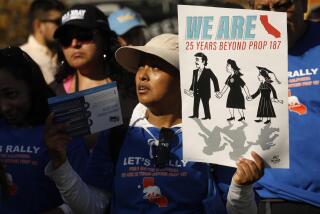Cash Transfers Get Faster, Cheaper
- Share via
Huntington Park — The king of King Express arrived at one of his 29 California outlets in a white Lexus, the essence of business cool: bold red tie, shoulder-length silver hair and glasses tinted a smoky gray.
He came north from Guatemala as a teenager. Forty years later, Francisco “Pancho” Leon is among the top regional players in the business of sending immigrants’ money home.
Messengers for his companies, Mexico Express and King Express, deliver more than $1 billion a year to rural Mexico and Central America, making the final leg of the journey by motorcycle, horseback and even the occasional canoe.
Scraped together by factory hands, nannies, janitors, dishwashers and other low-wage workers, such transfers from the U.S. to Latin America add up to more than $40 billion a year.
Telegraph pioneer Western Union has long dominated the market and continues to control nearly one-third of it. But over the last two decades, dozens of entrepreneurs have jumped in, driving down prices and ensuring that more money reaches its target.
On average, sending $300 to Mexico costs less than half of what it did in the mid-1990s, and the funds can arrive in minutes, as opposed to days. Advocates for the immigrants say costs are still too high. But Leon, who charges a flat $17 to deliver up to $1,000 to Mexico, insisted that he couldn’t go lower.
“It’s dog-eat-dog,” he said. “Nobody’s making money now.”
More than 20 competitors operate within a few blocks of his outlet in Huntington Park. Among them are international banks, two Western Union outlets and smaller, specialized agencies.
The Mexico Express office is utilitarian, with harsh fluorescent lights, green-and-white linoleum floors, and bulletproof glass protecting the cashiers. Leon let himself through a security door into the back office, where plastic bins held dozens of envelopes sorted by color-- blue for Guatemala, red for Mexico.
They would be carried south by couriers on commercial airliners, then given to messengers for delivery before the next sunset. The service appeals to workers whose families live far from the nearest bank or transfer agency.
Among them is Isidro Mata, a boyish 25-year-old who works two McDonald’s jobs and shares a Huntington Park apartment so that he can send at least $1,000 a month to support his wife and daughter, keep a brother in school and help other family members.
“There is nothing else,” Mata said of his home in Michoacan, where the buzz of Leon’s motorcycles is a reminder of the importance of exported labor. “Almost everyone depends on this.”
Leon’s service is among the most rudimentary in the business. Most others use agents who take in cash at one end and pay out in local currency at the other. The cost is usually a combination of a transfer fee plus a markup on the exchange rate, so customers must do some complicated math to compare offers.
Manuel Orozco, a Georgetown University researcher, said the price of sending money to Mexico averaged 4% to 10% of the total. He predicted that prices would drop further as more banks and electronic card companies began offering cheap transfers as a steppingstone to more lucrative transactions.
“The key will be in value added,” he said. But given the isolation of many families left behind, change will probably come slowly.
Raul Hinojosa, a UCLA professor of political economy who has studied the ties between the U.S. and Mexico for two decades, entered the business two years ago with a card-based remittance company called No Borders.
Working to link immigrant communities with their hometowns, No Borders offers some of the lowest rates in the industry: $7 to El Salvador, $10 to Mexico, with no markup.
Over time, Hinojosa envisioned selling telephone minutes, videoconferencing, cross-border health insurance, even home mortgages. But the business has fallen short of projections. Hinojosa recently sold a majority stake to an information services company, whose network will make the remittance card usable at any ATM in Mexico. No Borders will also be able to disburse in cash.
The launching of a No Borders agency last spring in the market town of Tlacolula, Oaxaca, illustrated why low prices didn’t guarantee success.
Many young men and women from the region work in Los Angeles. Hinojosa opened shop in a local Internet cafe and offered a day of free videoconference linkup to an office in Venice Beach. The offer drew hundreds. To accommodate them, Hinojosa dragged the computer outside, facing a plaza where a few goats nibbled.
For hours, the crowd was transfixed by emotional video reunions. But few showed any interest in Hinojosa’s money transfers, and those who did seemed confused. By the end of the day only two customers had signed up.
One was Adelberta Gutierrez Bautista, a 70-year-old widow. After a tearful video reunion with one of her 10 children, a Santa Monica dog groomer, Gutierrez came to collect the $100 he had sent. Hinojosa showed her how to load her card and explained that she could leave as much money on it as she wanted.
Skeptical, she held the orange rectangle up to the light. Then she asked for 200 pesos in cash, leaving nearly $80 on the plastic.
“Now it won’t be so easy to spend it all,” Gutierrez said, laughing, as she folded the bills and gave them a kiss.
Meanwhile, a traditional cash-dispensing outlet drew crowds throughout the day despite its higher fees.
More to Read
Sign up for Essential California
The most important California stories and recommendations in your inbox every morning.
You may occasionally receive promotional content from the Los Angeles Times.










